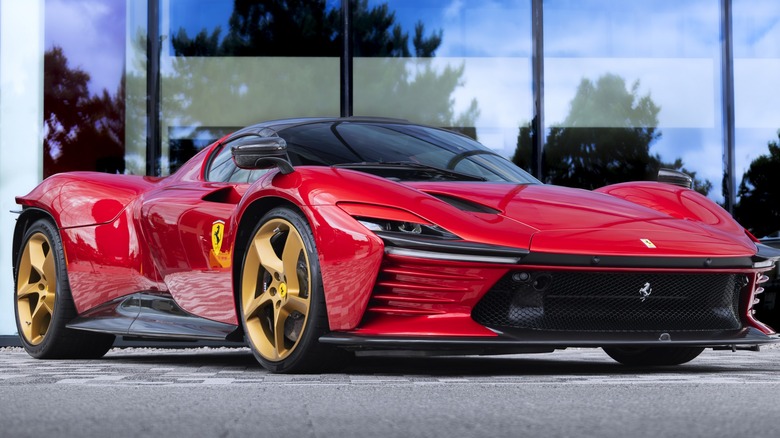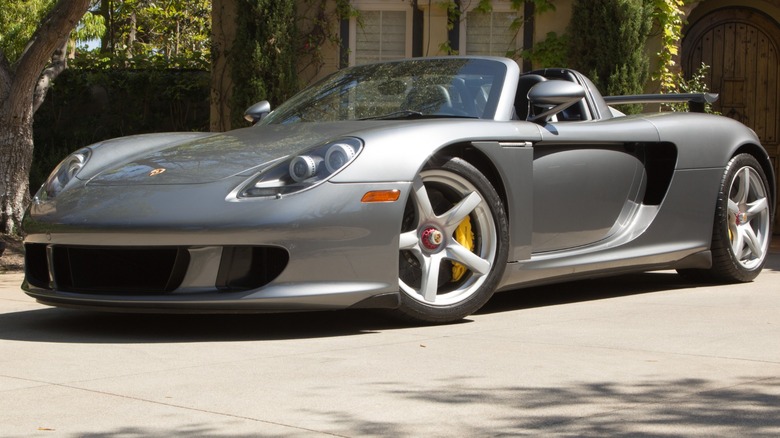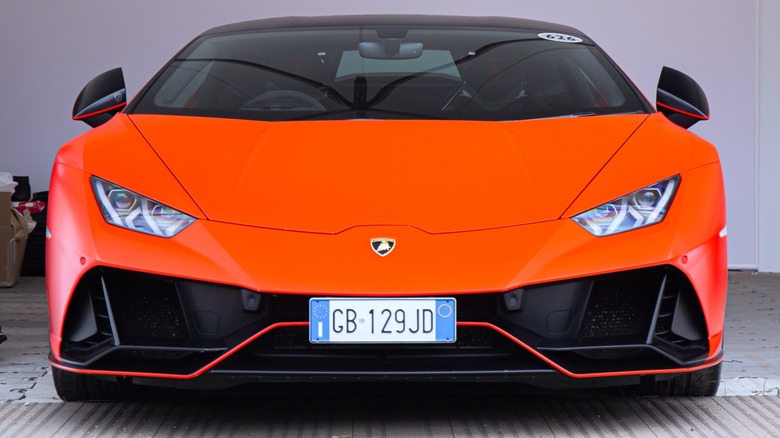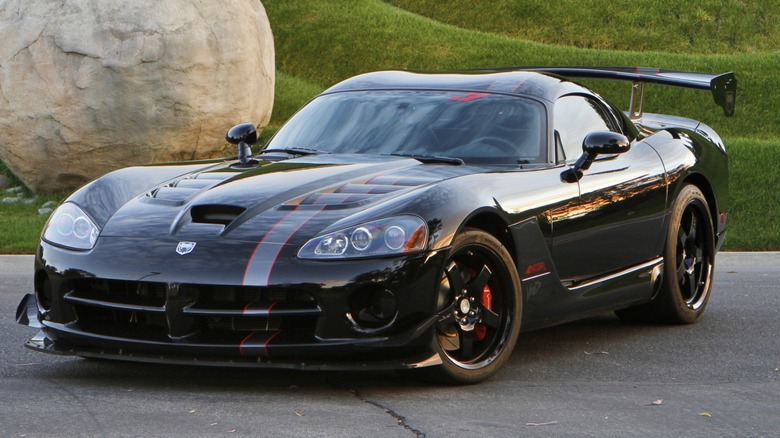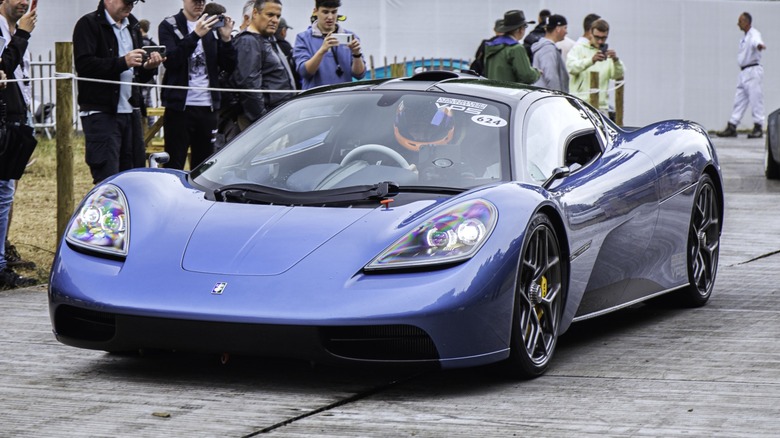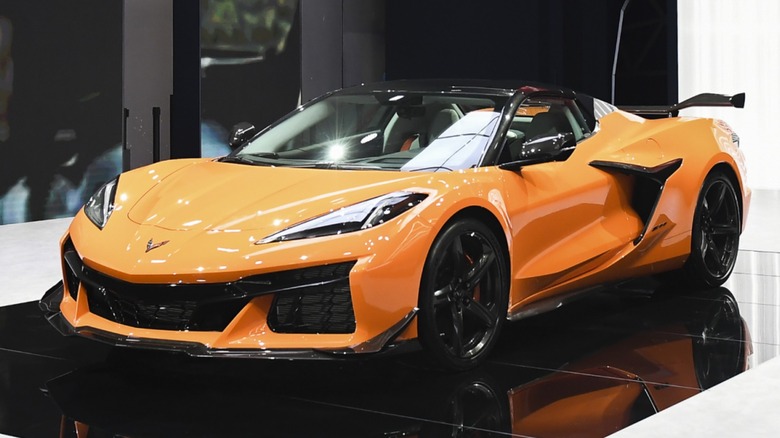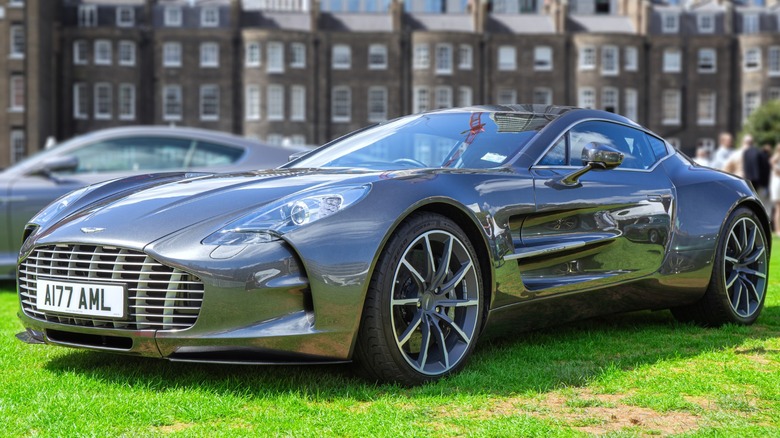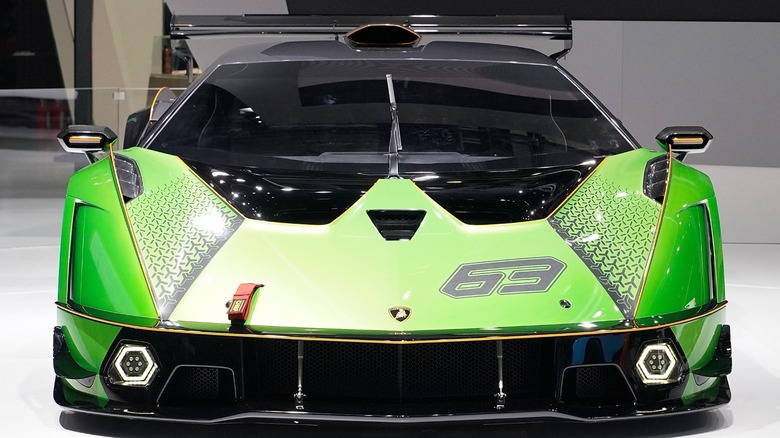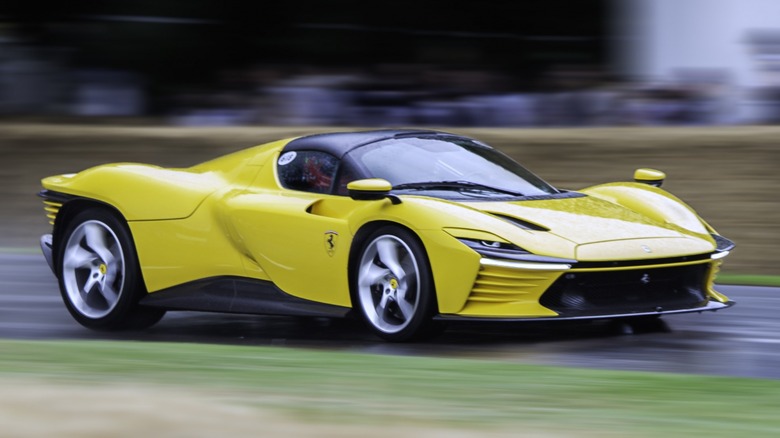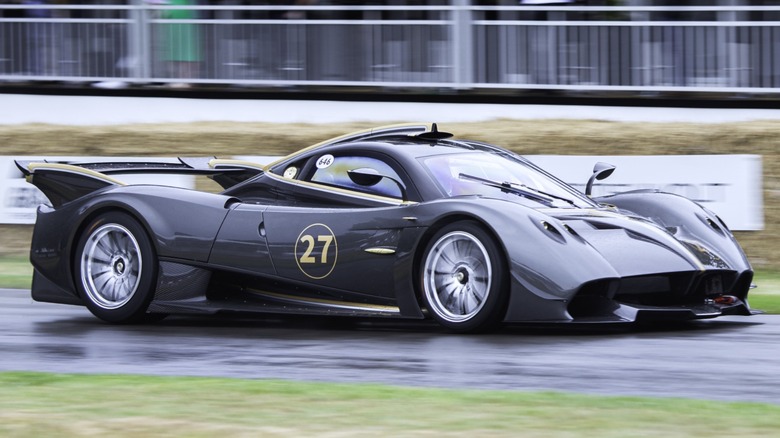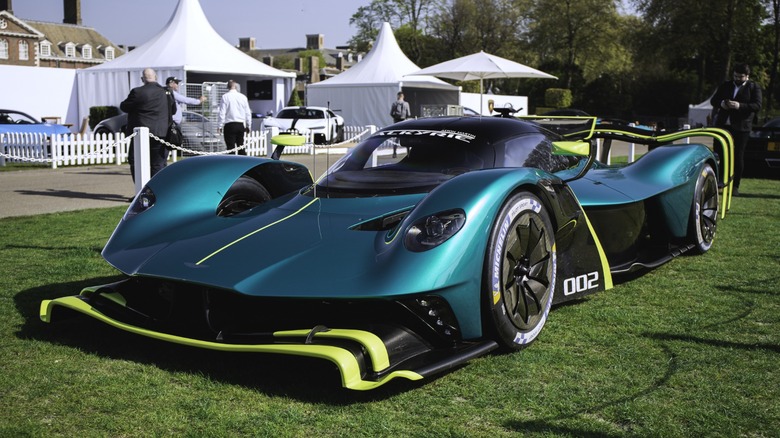The 10 Most Powerful Naturally Aspirated Engines Ever Made, Ranked
Modern sports cars are arriving at dealerships with increasing levels of power, pushing limits to the absurd. Technological advancements of the last few decades make this possible, along with the proliferation of buyers with large amounts of money to spare. While the most powerful cars of the '90s pushed 400 or 500 horsepower at the very top end of the range, many cars from mainstream automakers can be ordered with this level of performance. Furthermore, the development of forced induction — turbochargers and superchargers force air into the engine to make more power — has dramatically influenced the power output possible from modern cars.
With electric cars and hybrids threatening to take over the industry altogether, it could be seen as refreshing to know some "old-fashioned" engines still exist. These are engines making huge horsepower numbers without using any turbo or supercharger and pack tremendous amounts of technology into often surprisingly small packages. All of them are impressive, but here are 10 production cars featuring the most powerful naturally aspirated engines ever made, ending with the highest output.
10. Porsche Carrera GT V10 603 horsepower
Porsche has been responsible for some of the most cutting-edge, influential, and extraordinary supercars in its history. About once per decade, the Stuttgart company rolls out its latest high-performing model full of the latest technology, and that was the Carrera GT V10 in 2004. The carbon fiber beauty is known for being one of the last analog cars thanks to its traditional manual transmission, but also known for having an unorthodox engine for Porsche.
Porsche has built its legend on flat six-cylinder engines, which is why the 68-degree angle of the Carrera V10 is so unique. The powerplant used here almost never was. The original design came from a project built for Formula 1 in 1992 but was canceled. It was revived for a LeMans prototype, which was also canceled. But after Porsche had finally become flush with cash thanks to the success of the Cayenne SUV, they revived it once more to put in an innovative concept car that eventually received the green light for limited production.
Displacement is 5.7 liters and features 20 valves driven by dual cams with variable timing. The advanced engineering encompasses the engine along with premium materials. Cylinders are lined with nickel and silicon to reduce wear, and each bank of cylinders feeds into individual exhaust systems, with separate catalysts and silencers combining to make the most beautiful mechanical noise imaginable. Its output of 603 horsepower is tame by today's standards, but to hit that level without forced induction in 2004 was an impressive feat by Porsche.
9. Lamborghini Huracán EVO V10 631 horsepower
While Lamborghini had long rested its reputation on its mighty V12 engine, a V8 was offered on several lower-priced models. Once VW (Volkswagen) bought the company, many changes were instigated around the Sant'Agata Bolognese factory, which meant the lower-tier Lamborghini would now have a V10 behind the driver. This first model was the Gallardo, which was replaced in 2014 with the still-in-production Huracán.
Though it is the less expensive Lamborghini offered, it is by no means lacking in power and performance, nor is it cheap. The V10 carried over from the Gallardo has proven to be a potent powerplant created by skilled engineers. This V10 engine displacement is 5.2 liters and fits into relatively compact spaces thanks to its extremely narrow 90-degree angle. However, that does not prevent the automaker from bestowing it with twin cams operating four valves for each cylinder with variable timing in play. Furthermore, the most recent iteration of the engine utilizes both direct and indirect injection to ensure broad power delivery across the rpm (revolutions per minute) range, delivering the optimal quantity of fuel at just the right times to make the most power. In this case, the Huracán V10 produces 631 horsepower, which is up from the 601 horsepower when it first debuted in 2014.
An interesting note about this excellent V10 engine is that Lamborghinis are not the only cars in which you will find it. As a maker under the VW corporate umbrella, its technology is sometimes shared with other brands. In this case, the V10 can also be found in the Audi R8 supercar, although with a bit less power.
8. Dodge Viper ACR V10 645 horsepower
Long before the mid-engine Corvette debuted and even before the highly impressive Ford GT came out, America had a real supercar in the Dodge Viper. Developed in the 1980s, a time when 300 horsepower constituted a powerful car, the Viper proved that American automakers could make an adrenaline-producing automobile capable of keeping up with anything coming from Europe. It may not have been as refined, but it looked good and delivered brute force power courtesy of a unique and all-new V10 engine.
The Dodge Viper V10 was created when turbocharging was still in its infancy and confined to specialty performance cars only. Being a mainstream manufacturer of affordable cars, Dodge used the old formula for making horsepower — by making huge engines. The V10 that came out in 1991 was 8.0 liters, a gargantuan 488 cubic inches, and was the first American engine with more than eight cylinders since Cadillac and Lincoln retired the V12 engines of the '30s. In 1991, this was good for 400 horsepower, which was Ferrari and Lamborghini territory at that time. However, the Viper price was far less than any exotic from Italy.
As time went on, the Viper remained largely unchanged, receiving styling updates every few years. Throughout its production, the V10 remained an overhead valve engine relying on pushrods with the camshaft in the block and only two valves per cylinder — something President Washington could be proud of. Viper designers also eschewed any forced induction, only choosing more displacement to increase power. By the time the Viper was retired for good, the V10 had grown to 8.4 liters and produced 645 horsepower.
7. Gordon Murray Automotive T.50 Cosworth V12 663 horsepower
Many people, even the most strident gearheads, might now know who Gordon Murray is, but they probably know about his finest creation, the McLaren F1. He worked for McLaren Racing from the age of 26 and designed some of the most winning cars to ever enter an F1 racing circuit. Murray created that car after deciding he needed something new to work on, so he pushed McLaren into the business of building road cars. It was a stroke of genius, putting McLaren on the map as the producer of one of the finest cars ever built. He eventually left the company but had now embarked on another road car project, this time bearing his name.
His first new car was the T.50, and he enlisted the help of legendary engineering firm Cosworth to build a bespoke V12 to power it. With such a high bar set by himself, the T.50 had to go far above and beyond. The new engine powering this car is just 4.0 liters of displacement, which is impressive considering its output of 663 horsepower is accomplished without forced induction. Even more impressive is its redline at an astonishing 12,100 rpm. And to top those stats, it weighs less than 400 pounds in a car, with a total weight of just 2,174 pounds.
The list of impressive stats is lengthy, and the outcome of this partnership is a beautiful piece of machinery powering an equally beautiful machine. However, only those with a few million dollars will have the pleasure of experiencing it.
6. Chevrolet Corvette Z06 V8 670 horsepower
When Chevrolet introduced the rear-engine Corvette in 2020, it marked a revolution for the long-running sports car model. The entire makeup of the car had been changed, except for the engine. While virtually all European supercars featuring engines located behind the driver place the camshafts on top of the heads, Chevrolet continued to use a cam-in-clock design with pushrods pushing on the rocker arms as it had done since 1953.
The base model 2020 Corvette arrived in dealers with 495 horsepower, which was plenty to move the car very fast. Previous models of the Corvette had come out with more horsepower. In 2019, one could get the Z06 with 650 horsepower or the ZR1 with 755. However, both of these cars used superchargers for the boost in power. What makes the current Z06 such a fantastic machine is that it produces a phenomenal 670 horsepower without any forced induction at all. To get this amount of power out of its V8 without squeezing air into each cylinder required the use of dual overhead cams and a flat-plane crankshaft.
This 5.5-liter V8 comes with four valves-per-cylinder to move the tremendous amount of air and fuel through the cylinders and accompanies that by using forged aluminum pistons, forged titanium connecting rods, and a trick active split air intake with twin throttle bodies to control induction and increase flow. The result of assembling all these high-performance components is 670 horsepower, ready to shred the back tires of this American sports car icon by using sophisticated engineering rather than forced induction.
5. Aston Martin One-77 Cosworth V12 750 horsepower
Although Aston Martin has been producing some of the finest engines in the business for decades, including many V12 models since 1999, knows when to call in the professionals at Cosworth. They did just that when creating its bespoke limited edition One-77 grand touring supercar. Announced in 2009, this car would be an example of the finest Aston had to offer in terms of style and engineering, which was reflected in its price of £1,000,000 ($1,215,700), of which Aston required £200,000 ($243,140), just for the initial deposit before even seeing the car for the first time.
The car was to be fit with ultra-light material, which would also be spread throughout the engine components. Cosworth swelled the displacement up to 7.3 liters, used nanoscopic low-friction coating in lieu of cylinder liners, and tuned the total output to 750 horsepower. Surprisingly, little information about this engine has been published. What is known is that Cosworth used existing Aston V12 designs to create the engine, made sure it had 48 valves, cut the weight so that it was 25% less than the smaller 5.9-liter, and mounted it behind the front axle to make it a true mid-engined supercar and could propel the car to 60 mph in just 3.5 seconds. The other known tidbit is that Aston only made 77 of them, making it possible for only a precious few to get to know what it is like to drive with one.
4. Lamborghini Essenza V12 830 horsepower
For many years, Lamborghini has resisted the temptation to use forced induction to increase power. Even today, the only production car to brandish the Raging Bull logo with a turbo is its Urus SUV. Yet, producing cars with ever-increasing horsepower to remain competitive in the world of exclusive supercars has never been a problem for the brand. Year after year, Lamborghini produces some of the wildest and most powerful cars known to man. Its Essenza SCV12 model is no exception.
While it has been created for track use only, it is still a regular production model, albeit in extremely limited numbers — only 40 for the entire run. At the heart of it is, of course, a V12 engine. This one features a 6.5-liter engine with a specially designed exhaust system meant to reduce back pressure. With a total power output of 830 horsepower, this is an impressive feat of engineering, considering the engine is naturally aspirated, and it makes this the most powerful Lamborghini to be made without the help of hybrid drive or forced induction. The limited production run will not be the only thing keeping anyone off the street from having one of these incredible machines; the price tag of around $2.5 million will seriously tarnish most people's dreams of owning one, too.
3. Ferrari Daytona SP3 V12 829 horsepower
Although Ferrari has been using turbos and, more recently, hybrid drives to boost the power in some of its most powerful and exclusive models, the Moden company still knows how to lay down the gauntlet using good old-fashioned engineering prowess. New for 2023, the Daytona supercar sets the bar very high for style and power. Electric propulsion is creeping into every facet of automobile production, Ferrari models included. However, it seems Ferrari has released this car possibly as some kind of last hurrah for internal combustion. Not only is it a naturally aspirated and unaided V12, but the styling features many cues that harken back to Ferrari's past.
Powering this stunningly beautiful automobile is a 6.5-liter V12, the most powerful naturally aspirated version ever built by the company, and its output of 828 horsepower is stunning. And while many see the era of big V12 engines heading towards a close, Ferrari still sees potential, saying, "We are working a lot on the V-12 family because we think this is a very important pillar of Ferrari, with very special characteristics," according to Ferrari CTO Michael Leiters via Road and Track. This same engine was found previously in the 812 Superfast, producing 820 horsepower, and the engineers at Ferrari managed to squeeze eight more horsepower out of it for the Daytona. Perhaps this does signify that the V12 will enjoy a reprieve from the forces seeking its quick demise for the time being.
2. Pagani Huayra R V12 838 horsepower
If asked which carmaker produces the most beautiful and fast machines in the modern world, many will point toward Pagani. The boutique supercar maker from Italy produces only a handful of cars each decade, but the result of this work is nothing short of spectacular. However, having a beautiful car seems a hollow achievement if not backed up by equally impressive performance, and for Pagani, AMG helps to seal the deal.
Ever since Horacio Pagani first developed his debut Zonda model, his engines have been provided by the high-performance arm of Mercedes-Benz, AMG. But the engine in the exclusive and ultra-high-performance Huayra R model comes from HWA AG, a supplier of racing engines to AMG Mercedes-Benz. This ultimate Pagani model is the most powerful and exclusive of all, and it is powered, or more aptly said to be launched, by a 6.0-liter V12 producing 838 horsepower. And it does this without forced induction or hybrid power. This engine utilizes the kind of tech normally found on the track, including dry sump lubrication, direct injection, and lightweight alloys, and it is a stressed member of the carbon fiber chassis. The high horsepower output is achieved at an extremely high rpm of 8,250, and the redline is 9,000. However, as we all know, this kind of power does not come cheap, and the pleasure of driving one of 30 Huayra R models comes with an entry fee north of $3 million.
1. Aston Martin Valkyrie V12 1,001 horsepower
The clear winner of the naturally aspirated horsepower battle is the Aston Martin Valkyrie. Teaming up once again with Cosworth to create a V12 engine for the company's first proper mid-engine supercar, they have created a 6.5-liter V12 with a staggering 1,001 horsepower output. Combined with a hybrid assembly, the car's total power is 1,139 horsepower, but the engine alone outperforms anything on the market from any era.
The Valkyrie supercar is capable of hitting 60 mph in just 2.3 seconds. Everything about it is made to get it down the road as fast as possible, yet it manages to look good in the process. As this was the first car of its kind for Aston to produce, it is safe to assume they wanted to get things right and show the world it would be worthy of entering such rarified air. Even when Aston approached Cosworth to build the engine, a horsepower rating of 950 was deemed to be sufficient. It was only after Cosworth got to work that it was found to be capable of more.
The Valkyrie is not the most powerful supercar on the market, but it is the only naturally aspirated one. Cosworth had to employ a range of high-strength alloys in its building, but the key to making this engine work was gaining efficiency wherever possible. That means reducing constrictions in airflow while reducing friction elsewhere. The lightweight components make high rpm possible, and meticulous calculations, testing, and research helped it all combine to make the most powerful engine of its kind today. Kudos to Cosworth for such a success.
